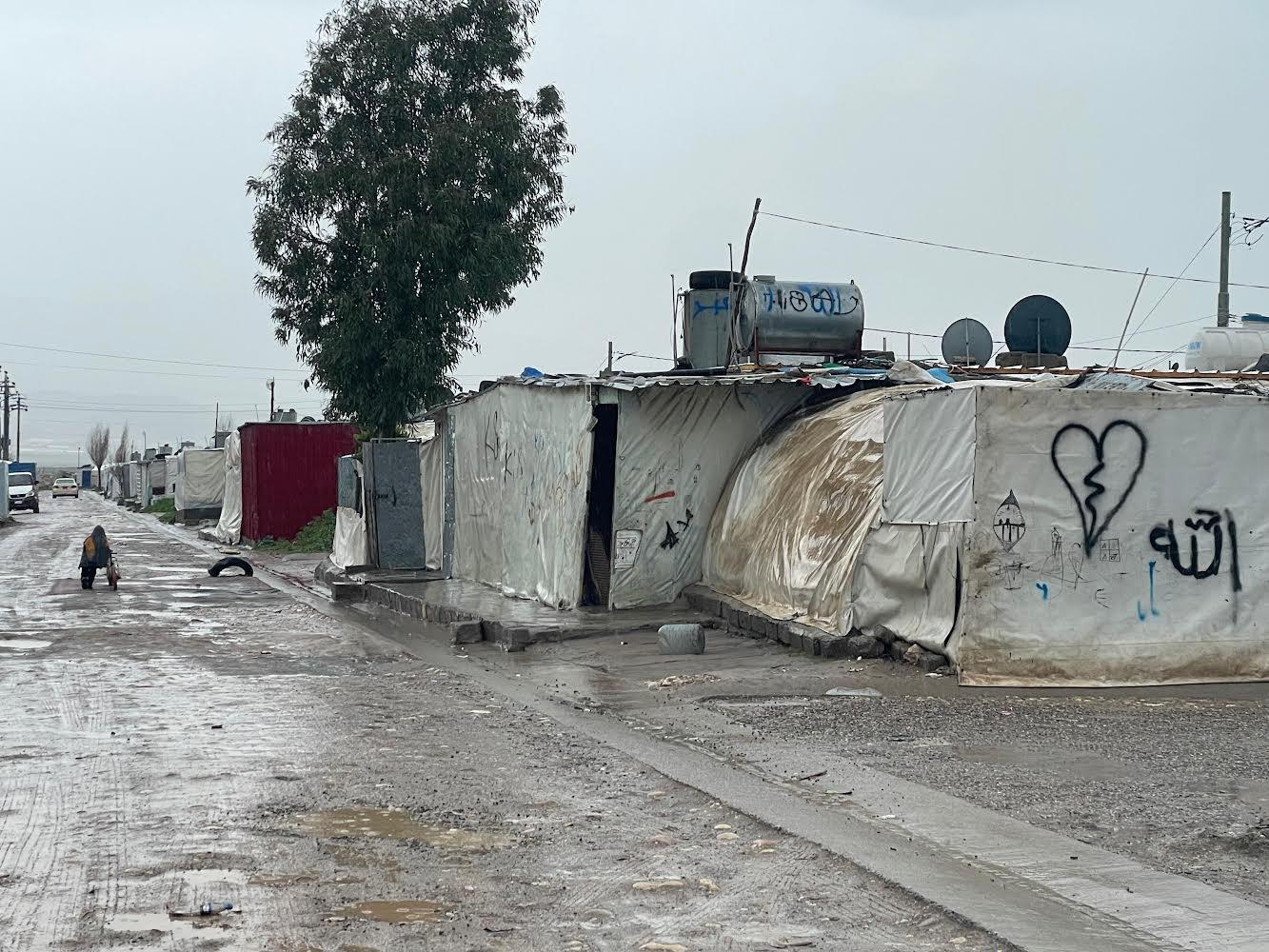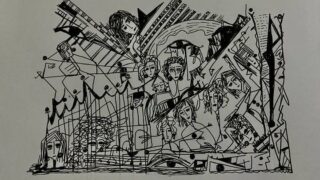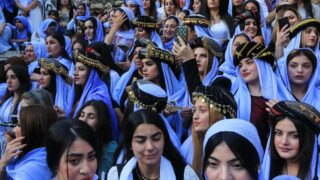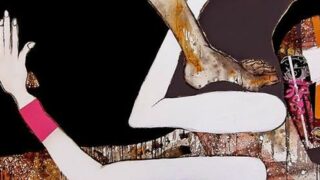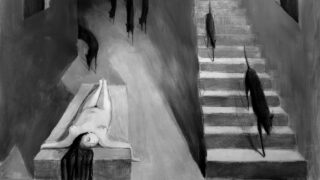“The first Daeshi[1] who bought me told me he had paid $500 for me," says Fatima, a survivor of four years of captivity in ISIS prisons, between Iraq and Syria.
How is Fatima expected to live in her country after her liberation - a woman who was once just a nine-year-old child, sold to members of a terrorist group that cloaks its brutality in religious ideology, promising its fighters a second life filled with every imaginable pleasure? It all happened by cruel chance, in a village where life crumbles like its mud houses, perpetually on the brink of collapse. She was sold not once, but several times, each time at a different price. She was treated like a commodity, her value shifting with the market, especially with the arrival of newer, “virgin” goods.
The August sun floods the cities and villages. The mirage casts waves that make distorted people-like shapes, filling in for all those who had escaped toward Mount Sinjar, its peaks jutting into the sky like knives that tear into life itself, or that pierce into Noah’s Ark[2].
Death is a Woman from Şingal
05-06-2024
They scatter like ants: alone, in pairs, in desperate clusters. Young men carry their fathers, mothers, and grandmothers on their backs. Others carry only the burden of loss: the grief of families killed, the exhaustion of burying loved ones along a road that leads nowhere.
Old women dressed in white, their backs bent under the sun's whipping heat, their breasts long dry of milk. Still, their children clung to them, suckling in a futile attempt to distract themselves from dying of thirst. Men urged their families to keep moving, while all they could do was shed tears; abundant, overflowing, salty, and hollow, warding off death. Women thought only of their children. Some were forced to leave their little ones’ lifeless bodies behind on the roadside; the grief for their children keeping them from paying any attention to the fear for their own lives.
Fatima was denied even the dignity of death, though it circled close, its breath thick with the dust of earth. She was abducted by ISIS fighters at the age of nine, before she had even fully grown into her childhood. Her thin, fragile body that looked like a bamboo reed was taken to Syria. She was one among hundreds of women, cloaked in black abayas that fell over them like eternal night. They were sold, exchanged, and gifted like property among ISIS members.
Fatima Mohammad, or…
“I was nine years old when ISIS kidnapped me. I spent four years in captivity, during which I was sold eight times.” Her voice is sharp as a knife, cutting through the air between us, laced with a hoarseness that crushes the heart of the listener. Fatima Mohammed recounts her story, looking at me with lightless eyes and a face worn by ten years of a life never lived; a life in which she was buried every single moment.
“I was freed on April 20, 2018. I was 13 years old at the time. Now I live in the Khanke informal camp,” Fatima said. Khanke is a makeshift IDP camp that consists of tents distributed haphazardly, without a fence or protection. Fatima obtained her tent through the Khalsa Aid Organization.
The Land of Clipped Braids
23-03-2025
"I was smuggled out after the Kurdistan Regional Government's Office for the Rescue of Kidnapped Yazidis paid $18,100. However, I was lost for six months in Deir ez-Zor, in Syria, because the smugglers who got me out of ISIS prisons were supposed to drop me off at a Kurdistan Workers' Party (PKK) checkpoint, but they didn’t, as the PKK had moved their checkpoint forward in the morning. I had arrived there before sunset, so I had to find another way to get there,” Fatima explained.
Old women dressed in white, their backs bent under the sun's whipping heat, their breasts long dry of milk. The women thought only of their children. Some were forced to leave their little ones’ lifeless bodies behind on the roadside - the grief for their children keeping them from paying any attention to the fear for their own lives.
Fatima sought refuge in a mosque in Deir ez-Zor and confided her fears and circumstances to a man named Ammar. She recounts: “Ammar had been forced to flee his home and take shelter in the mosque in Deir ez-Zor after fighting intensified between armed groups on one side, and against ISIS on another.” Ammar realized that the world around them was becoming harsher than stone, and he decided to care for Fatima.
“The man treated me like a sister. Three months later, I went with him and his family to al-Hawl[3] Camp, and I became a resident there…” With a painful smile, she continues: “One day, he asked me if I knew the name of the mountain visible from the camp. I shook my head. He lowered his gaze and said it was Mount Sinjar. That was when I wondered if my family had been freed. I thought, why couldn’t I return to them?”
Fatima had received numerous offers from smugglers in Syria to take her back to Iraq. But having been sold eight times, she had learned that profit mattered more than people. She was terrified that she might once again turn into a commodity, so she refused.
Fatima believed the past still awaited her, that the world would not begin to change until she was back in Sinjar, or Şingal, among her people. Every moment of her life in exile, spent in a barren land, where the only gods were false ones declared on black flags, from screaming throats that called for slaughter and death… every moment there was beyond time and reason.
"I asked Ammar to try to reunite me with my family," she says. Fatima, with her zest for life and almost miraculous optimism, transformed the small tent window into a portal to an imagined future; one where an angel would appear, bathed in light, manifesting each of her family members and extending a hand toward her. In the angel’s palm, she imagined her village as it looked before it was overtaken by those who called themselves “God’s soldiers, the mujahideen,” self-proclaimed bearers of truth, sent to force the “misguided” and “polytheists” onto their supposed path of righteousness.
Fatima recalls: “I told Ammar I wanted to return to my family, even though I knew ISIS had arrested them. Still, I couldn’t rule out the chance that some might have been liberated. Two of my brothers weren’t in Şingal when ISIS attacked. I gave Ammar all the information I had, including their last known places of residence, and he passed it to a ‘wise guy’ in Syria.
After a lot of searching and questioning, the mediators succeeded in contacting my brother. They asked him whether he had a sister, giving him my description. They told him that I was in Deir ez-Zor, but they didn’t specify that I was in al-Hawl Camp. The plan was for him to be brought to a nearby tent so I could observe him first, from a distance, through my tent window. Once I confirmed it was him, they would allow him to come to my tent.
And it happened just as we planned. My brother was able to enter the camp using a medical prescription to visit the health center. As he walked by, I recognized him from my window. I saw him searching for me, and signaled to them. Yes, it was him.”
Fatima’s brother’s visit, in its philosophical dimension, can be seen as the cry of a soul pleading to return from death, because her life is not yet over. In its human dimension, it resembles the image of a tortured woman transforming the shackles on her wrists into anklets for dancing, and the ropes around her neck into a necklace, and her prison into a resting place and an earthly home for her angels.
While Sisyphus was condemned to an eternity of futile labor, endlessly pushing a stone toward a meaningless goal, Fatima embodies the opposite force. She smiles, even though that smile bears the weight of countless sorrows, and she climbs, even from within the catacombs of the underworld and its deepest, darkest pits where she was banished. She climbs a ladder toward the light, leaving behind childhood nightmares and imprisoned dreams.
After intensified bombings struck ISIS strongholds in Deir ez-Zor, the man who rescued Fatima secured a fake ID for her. All residents of the region, regardless of their affiliations, were forced to flee, many finding temporary refuge in the al-Hawl camp.
"I asked Ammar to try to reunite me with my family," she says. Fatima, with her zest for life and almost miraculous optimism, transformed the small tent window into a portal to an imagined future, where an angel would appear. In the angel’s palm, she imagined her village before it was overtaken by those who called themselves “God’s soldiers, the mujahideen,” self-proclaimed bearers of truth, sent to force the “misguided” and “polytheists” onto their path.
Fatima Mohammad spent three months in Deir ez-Zor and another three in al-Hawl camp under a false identity. Her real name is Fawzia Bashar Khalaf, a Yazidi child who came of age and grew older every time she was ‘sold and bought’. She came up with her pseudonym and secured a fake ID to survive in al-Hawl Camp, where ISIS cells remain active, with their underground tunnels used for smuggling weapons, materials, and people. Al-Hawl camp, which houses approximately 45,000 refugees of various nationalities, is under the control of the Syrian Democratic Forces.
“They wouldn’t have allowed my brother to enter the camp if it weren’t for his medical condition, which we faked using a forged prescription,” she says. “After spending a night in the camp, he approached the administration and told them he had come to retrieve me. They denied the presence of any Yazidi women in the camp. But he insisted, saying he had just met me. The officials were shocked that we had managed to meet me at all without their knowledge.”
After her release and return to Iraq’s northern Kurdistan, Fawzia settled in the informal Khanke IDP camp, where she now cares for her two younger brothers in one of the tents. Her parents remain missing, still held in captivity.
I asked her whether any Iraqi government agency had reached out to assess her situation or provide assistance. She shook her head. “No one has bothered to visit,” she said. “What we, the freed female prisoners, need most is a serious investigation into the prisons in Syria, into al-Hawl camp, and, more importantly, into the mass graves and the identities of their victims.”
Fatima Mohammad spent three months in Deir ez-Zor and another three in al-Hawl camp under a false identity. Her real name is Fawzia Bashar Khalaf, a Yazidi child who came of age and grew older every time she was ‘sold and bought’. She came up with her pseudonym and secured a fake ID to stay alive in al-Hawl Camp, where ISIS cells remain active.
Of the 24 members of Fawzia's family, 14 remain unaccounted for, including her parents. “At a time when I needed two parents to care for me, I became both a father and a mother to my two younger brothers," she says.
Like many other survivors freed years after years of captivity, Fawzia faced rejection from the Iraqi Ministry of Education. When she attempted to return to school to complete her education, she was denied admission on the grounds that she was “too old to meet the enrollment criteria”. Those schools that lack textbooks, employ unqualified teachers, have crumbling infrastructures, and are housed in temporary caravans, despite costing billions of dinars, still had no place for Fawzia or others like her.
How Do Yazidi Women Survive in Iraq and Syria?
Hundreds of survivors of ISIS captivity live in conditions wholly unfit for adults who have endured physical and psychological torture or for children who were armed and trained for suicide missions. The environment they are forced to endure is one of immense misery. They live in nylon tents that offer the only shelter amid temperatures that soar above 40 degrees Celsius in the summer and plunge below zero in the winter.
Hala Safil, a young Yazidi woman who survived captivity in ISIS prisons, tells me that she believes those who have been liberated from ISIS are not truly free. “They say Hala Safil was freed, but that’s not true," she says. “I have not yet been freed. If I live in Iraq, I don’t have the freedom to speak the truth…” She continues, “Even the women and girls who escaped ISIS prisons are not free. As soon as they’re ‘freed,’ the tent awaits them. When my new home is a tent, it feels like I’m sleeping in my own shroud, never knowing if I’ll make it to morning, whether because of a fire that consumes the tent or a storm that tears it from the ground.”
I asked Fawzia whether any Iraqi government agency had reached out to assess her situation or provide assistance. She shook her head. “No one has bothered to visit,” she said. “What we, the freed female prisoners, need most is a serious investigation into the prisons in Syria, into al-Hawl camp, and, more importantly, into the mass graves and the identities of their victims.”
Like many other survivors freed years after years of captivity, Fawzia faced rejection from the Iraqi Ministry of Education. When she attempted to return to school to complete her education, she was denied admission on the grounds that she was ‘too old to meet the enrollment criteria’.
During its assault on Yazidi communities, ISIS trafficked women deemed “fit” for childbearing, primarily those labeled as virgins, selling them in slave markets it established in the Raqqa region of Syria. Those considered unfit for this purpose were buried in what was known as the “Mothers' Grave,” a mass grave where Yazidi women, particularly mothers, were buried alive in front of their families and children. This horrific site is believed to contain the remains of approximately 80 women. In addition, another mass grave was discovered, containing the bodies of Yazidis who were brutally executed by ISIS after the group declared the violation of their homes, lands, women, and lives to be permissible.
Logical Solutions for “Religious Minorities”
Refugee camps were established in Iraqi Kurdistan to house people displaced from areas attacked by ISIS, which destroyed their livelihoods by slaughtering men and whoever refused to join its ranks.
Initially, there were more than 25 camps spread across Dohuk, Erbil, and Sulaymaniyah. International humanitarian organizations gave support to the camps in the form of mattresses, blankets, tents, and other supplies.
After ten years of war and seven years since defeating ISIS, these camps still house 4,232 families, comprising approximately 20,000 individuals, 9,719 of whom are males and 10,274 females. The number of those under four years of age is estimated at 1,573, those between 5 and 17 years old at 6,279, those between 18 and 58 at 11,234, and those 60 and older at 907.
The number of widows in the Cham Mishko camp is 399, orphans 224, and people with disabilities 251. The number of survivors from ISIS prisons is 50. The rest had their homes destroyed and sought refuge in camps.
There are 5,000 tents in a single camp, some housing families of seven or more, living in misery and chronic disappointment. There are tents inhabited by widows and their children, in the absence of their husbands and with the constant presence of a deep wound in their hearts that could engulf the entirety of the world outside their camp.
It is known that bamboo reeds that are cut at any level of the stem and planted elsewhere, will take root and grow again. Fawzia, after repeatedly gathering the shattered pieces of her soul, did the same. Caring for her two younger brothers became her way of planting her roots and distracting herself from death.
Despite passing the Yazidi Female Survivors Law in 2021, Iraqi authorities waited four years after liberating ISIS-occupied areas to acknowledge the suffering of the affected women, the need to provide them with care, and the vital role these women played in preserving Iraq's religious and cultural diversity. The law includes recognition of the genocide committed against the Yazidis and provisions of compensations to survivors. By (an expected) chance, the facade soon crumbled, revealing the violations and injustices beneath it.
Women survivors of ISIS captivity organized a protest, rejecting proposed amendments to the law. These changes included a requirement for forensic and clinical evidence to prove women’s exposure to physical violence, which posed a clear violation of established international law. As Amnesty International has affirmed, a victim’s testimony alone should be sufficient to secure compensation.
The Lifemakers of Iraq
21-10-2022
It is known that bamboo reeds that are cut at any level of the stem and planted elsewhere, will take root and grow again. Fawzia, after repeatedly gathering the shattered pieces of her soul, did the same. Caring for her two younger brothers became her way of planting her roots and distracting herself from death.
At the end of our talk, I asked her what she expected from the world. Her voice was hoarse, as her eyes drifted indifferently toward the tent’s window. Noises of life rose around us, as if it had suddenly sprung out of nowhere.
“Nothing,” she said.
Translated from Arabic by Sabah Jalloul.
- ISIS member. ↑
- Some believe that the name Sinjar was given to the mountain and the city because Noah’s Ark is said to have sailed there and struck the mountain’s sharp peak. According to legend, Noah exclaimed, “Hādhā sinn jar ʿalaynā” (meaning: “This is a sharp tooth that has harmed us”), which is thought to have given the place its name. ↑
- Al-Hawl Camp is located in northeastern Syria, in the Hasakah region. Some of the camp’s residents were suspected of having close ties to ISIS. Some were the families and wives of ISIS members. However, the camp also housed Yazidi women kidnapped by ISIS. For years, it has been a ticking time bomb that could be used as grounds for re-spreading ISIS ideology. It has been inhabited by some extremists and has been used as a crossing point for ISIS members to enter and exit the camp. Tunnels were discovered beneath the camp, used to transport weapons and ISIS members. The camp also contained a secret detention center where those who refused to comply with ISIS laws were tortured. ↑

